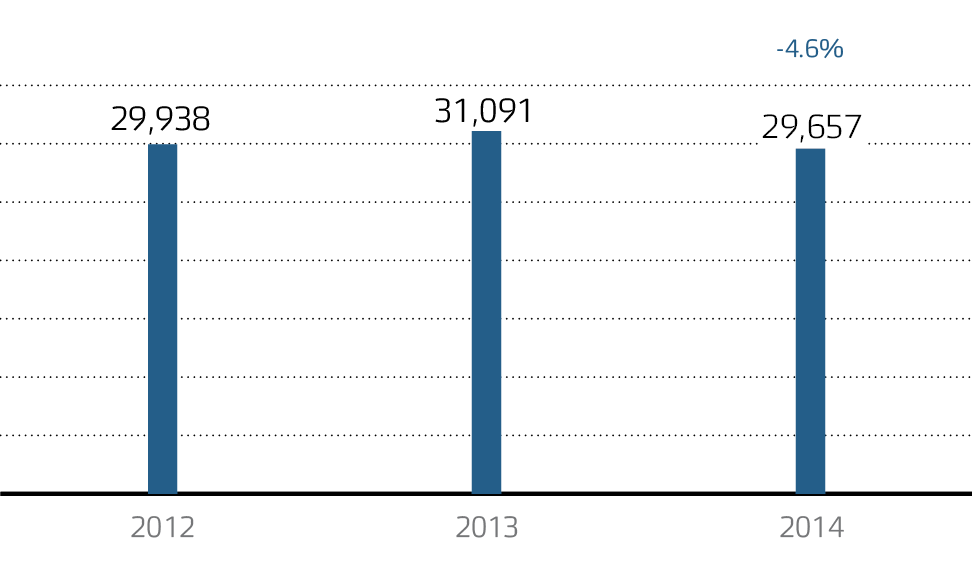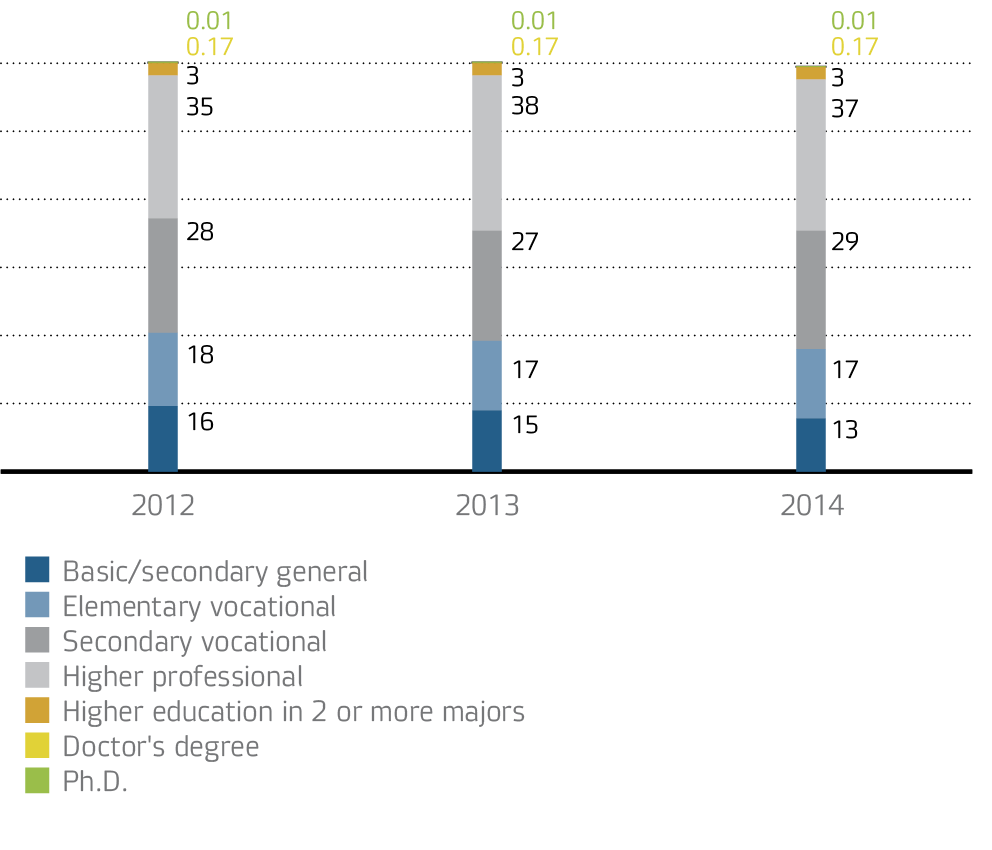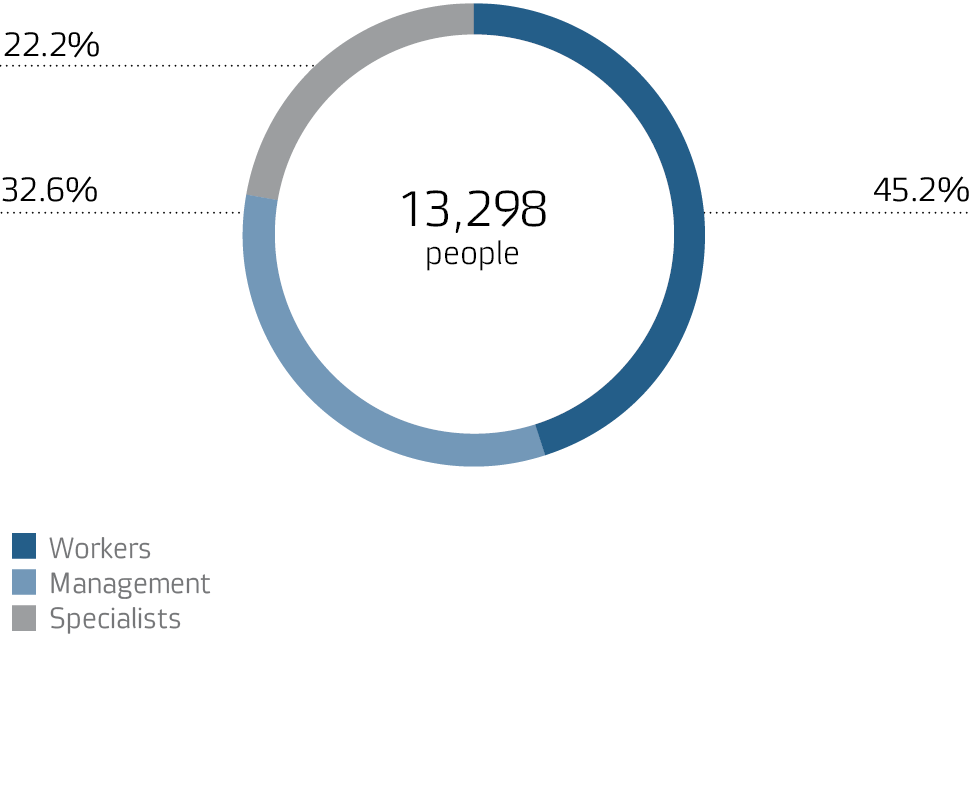In 2014, the Board of Directors approved an internal document, which became the cornerstone of the activities, implemented by the Company, i.e. HR and Social Policy of IDGC of Centre, Minutes of the Board of Directors dd November 28, 2014 No. 26/14.
Personnel training and development
Social benefits and protection
Staffing level
The average number of employees of IDGC of Centre in 2014 comprised 29,657 employees, which is by 4.6% less than in 2013.
Decrease in the personnel number in 2014 is mostly caused by IDGC of Centre being deprived of the SLR status and, consequently, having to lay off its employees, as well as by holding activities on optimisation of the number of office and management personnel and transfer to outsources of the house keeping functions. Growth of the average staffing number in 2013 was caused by IDGC of Centre acquiring the SLR status in compliance with the order of the Ministry of Energy of the Russian Federation and hiring personnel for operation in the field of power supply.
The staffing level in 2014 was 95% as of the end of the year, which corresponds to the levels of 2013 and 2012.
Average number of employees in 2012–2014, people
Distribution of average number of employees in 2014 by branch, %
Employee structure by category, %
The personnel structure, broken down by category, is typical for the power-grid complex companies and has remained stable over the last three years: workers constitute most of the Company’s staff, accounting for 51%.
Decrease in the number of specialists and office staff by 2 per cent in 2014 was caused by giving up by IDGC of Centre of the SLR status and holding activities on optimisation of the number of office and management personnel. Increase in the number of workers by 2 per cent resulted from filling positions in the distribution zones and creating a distribution zone Yargoreletroset in IDGC of Centre branch Yarenergo.
The main pool of the Company’s personnel comprises employees in the age 25–50 years (66%). The Company’s structure, broken down by age, remains stable: over the period 2012–2014 staff age correlations experienced almost no change.
Employees’ average age equals 41 years. In 2013–2012, this indicator was equal 40.8 and 40.6 years respectively.
The Company’s personnel possesses high level of qualification; about 87% of the employees received professional education. High level of current technologies in the field of power supply require that qualification of the Company’s personnel is enhanced and improved. Analysing personnel educational level demonstrates that the share of employees without professional education drops down yearly.
Employee structure by age, %
Employee structure by level of education, %
Personnel training and development
The system of IDGC of Centre personnel education and development is intended to maintain professional and educational level of the employees in compliance with the Company’s development strategy and is aimed at creating conditions for vocational and personal growth of its personnel. In compliance with the Rules of HR Management in the Power Energy Sector of the Russian Federation, advanced training of employees should be of continuous nature and carried out throughout the entire working career. The need to advance professional training results from personnel having to face the industry challenges and increased social weight of the power energy sector enterprises.
Training, retraining and advanced training of employees is planned in accordance with the applications of the Heads of the structural divisions, subject to scenario conditions, business need, laws and regulations of the Russian Federation.
The following criteria are placed the most emphasis on upon making educational and training programmes:
- the need to train the production personnel, busy in execution of the Company’s core activities;
- regularity of the personnel advanced training;
- meeting the requirements on preexamination training of employees of hazardous industrial facilities;
- first-aid training;
- training of the rules, requirements and instructions on technical operation, occupational, industrial and fire safety;
Taking due account of the nature of activities of the Company and its targets in staff training, the structure of employees to have participated in the educational activities is characterised by predominance of workers and production personnel.
Distribution of the trained employees by category in 2014, %
Ratio of employees who took part in training activities, and the level of training costs in relation to the payroll in 2014, %
|
Share of employees who received training, % |
Share of employees who received training based on the Company’s own training centers |
Correlation of training costs to LCF |
| Belgorodenergo |
36.9 |
0.5 |
0.27 |
| Bryanskenergo |
36.0 |
0.4 |
0.44 |
| Voronezhenergo |
34.0 |
22.0 |
0.70 |
| Kostromaenergo |
55.3 |
0 |
0.77 |
| Kurskenergo |
68.1 |
0 |
0.35 |
| Lipetskenergo |
49.7 |
0 |
0.44 |
| Orelenergo |
55.0 |
20.0 |
0.60 |
| Smolenskenergo |
28.1 |
3.8 |
0.57 |
| Tambovenergo |
48.8 |
0 |
0.43 |
| Tverenergo |
4.0 |
24.4 |
0.55 |
| Yarenergo |
50.1 |
1.7 |
0.99 |
| Executive office |
42.8 |
0 |
0.64 |
In total, in 2014 educational activities were attended by 13,298 persons, or 44.8% of the Company’s personnel.
The Company’s staff training activities are carried out in two ways:
- on-the-job place personnel training (based on its own classrooms, operating staff training grounds);
- full-time training in the specialised educational institutions and training centres (professional training, retraining and advanced training of staff).
The graph demonstrates comparative data on the share of employees to participate in the educational activities, amount of training costs as compared to the labour compensation fund (%) as per each branch.
IDGC of Centre is the founder of three training facilities:
- Tver Training Centre Private Institution.
- Energetik, Voronezh Training Centre Private Educational Institution.
- Orlovsky Training Complex Private Educational Institution.
The training centres are licensed to conduct training activities; these are key educational institutions to meet the need in educating employees of the Company’s branches in the respective regions.
The major part of the educational activities, carried out by the training centres, falls onto preparation of dispatchers, foremen, electricians of various specialisation, electrical fitters.
2,038 individuals, or 15.3% of the trained staff, received education based on the training facilities established by IDGC of Centre.
Interaction with training facilities
In the field of (advanced) staff training, the Company cooperates with the number of higher, secondary professional and vocational educational institutions, including NRU Moscow Power Engineering Institute, Ivanovo State Power Engineering University, St. Petersburg Power Engineering Institute of Further Education, Rostekhnadzor training centre.
In order to ensure for better-quality training, recruitment and development of electrical engineering personnel, the Company concluded long-term partnership contracts with the number of higher and secondary professional educational institutions. Partnership programmes are implemented both at the level of the Company’s executive office, and at the regional level by IDGC of Centre branches.
Talent pool
IDGC of Centre forms management talent pool and young-specialist talent pool both for the executive office of the Company and its branches.
In October 2014, the management talent pool was formed to include the following positions:
- Executive office: Deputies General Director, Heads of departments directly reporting to the General Director.
- Branch management: Deputies General Director, Branch Director, Heads of departments directly reporting to the Branch Directors, PGC Heads and Chief Engineers.
Out of 411 appointments to upper positions, made in 2014 in the branches and executive office of the Company, 235 Heads (57.2%) were appointed from the management and young-specialist talent pools.
Staff Motivation
Employees’ Incentives
| Financial incentives |
Non-financial incentives |
| Tariffs |
Variable renumeration |
Moral encouragement system |
| Salary |
Additional payments as percents to salary |
Outstanding performance |
Implementation of innovative projects |
Years-long dedicated work |
Financial incentives
The Company labour compensation plan is organised in compliance with the requirements of the Labour Code of the Russian Federation, local norms of IDGC of Centre and Sectoral Tariff Agreement (from hereinafter — STA) in the Power Energy Sector of the Russian Federation for 2013–2015. The Company operates using a unified tariff system of IDGC of Centre, stipulating for labour compensation basing in tariff rates (official salaries), determined depending on skill category and job title, and allowing to differentiate labour compensation of employees taking due account of the level of professional qualification and special aspects of the structural division, alongside with of the level of difficulty and responsibility of the performed works (functions).
Tariff rates are defined based on the minimum monthly tariff rate of a first-rate wageworker (MMTR). In accordance with the Collective Labour Agreement of IDGC of Centre, MMTR is adjusted in compliance with index.
In 2014, the employees’ average wage grew up by 16% as compared to 2013, which was caused by adjustment according to index of the tariff rate in Q4 2013 and corresponding growth of the variable part of wage, based in tariff rate (official salary).
IDGC of Centre wage indexation allows to keep average wage of the branch employees above average payment throughout the region.
In every branch average wage is different and depends on specific aspects of the particular region and the amount of the established tariffs, as well as on different levels of the staff turnover, and consequently, on the need of the branch to keep highly-qualified employees by means of increasing key-profession average wage level.
With the view to increase key-profession average wage level, following the results of further training tariff level factors are increased, an increment for professional excellence and high-level qualification is added.
Additional material incentives
Apart from salary, the Collective Labour Agreement of IDGC of Centre and other internal documents of the Company define other additional payments (variable part of wage):
- bonus payment for key production and economic indicators;
- additional payments, relating to labour routine and labour conditions;
- payment for regular and additional vacation leaves;
- long-service award;
- leave financial assistance.
Correlation of average wage of the branches employees to average wage in the regions in 2014, RUB thous.

Non-financial incentives
IDGC of Centre follows a system of incentives for achieving outstanding results, conducting innovation projects, and for the diligent loyalty to the Company over a long period of time.
In 2014, 10 employees of the Company received national awards, another 332 received awards from the Ministry of Energy, yet another 250 received corporate awards from JSC ROSSETI; 70 employees were awarded by the All-Russian Association of Employers of the Power Sector, and 713 employees were awarded by IDGC of Centre. One company employee was awarded by placing his name on the Power Industry Honour Board, and 10 more were listed in the Power Industry Honour Book. Three employees were awarded a commendation by the President of the Russian Federation for construction and significant contribution to reliable operation of the Sochi distribution zone PGC Olympic facilities, one employee was awarded a commendation by the Ministry of Energy of the Russian Federation, and 408 employees of the Company were awarded corporate awards by JSC ROSSETI.
Social benefits and protection
Key areas of social policy
| Social benefits, protection and compensations |
Insurance |
Housing policy |
Private Pension Scheme |
| Lump-sum payments in compliance with the Collective Labour Agreement |
Voluntary medical insurance
Accident and sickness insurance |
Compensations for the rent of accommodation
Compensations for part of mortgage interest under mortgage contracts |
Supporting employees to take their well-deserved rest |
| RUB 761.3mln |
RUB 188.8mln |
RUB 22.2mln |
RUB 155.5mln |
Apart from the above mentioned social programmes, IDGC of Centre pays considerable attention to the following areas of social work.
Each branch of IDGC of Centre has the Veterans’ council that serves as a link between retirees and branch management, helps to identify retirees in dire need, and cooperates with the branch management to organise corporate events.
With the view to develop interaction with young specialists every branch of IDGC of Centre operates a Council on the Youth.
Vocational guidance is carried out at schools and aims at detecting and selecting the most prominent and prepared students to be offered employer-sponsored education at the educational institutions the Company has agreements with. Students of these educational institutions receive practical and pre-graduation training at the Company. Scholarships by IDGC of Centre are allocated, graduates assignment is made personally.
The Company arranges Summer and Winter Games, and so-called “Merry Ready-Steady-Go” Games (“Veselyie Starty”) to engage the employees’ families in sports activities.
Different competitions, for the best children’s composition or drawing on various subjects, are held among children of the employees. Among popular activities, carried out by the Company, are contests, shows, excursions, corporate recreation at weekends and holidays, all kinds of competitions among children of the employees and retirees (artistic, literary, photo contests, children’s crafts competition). New Year festivities are arranged for children of the employees on regular basis. Charity events of assistance to orphanages are held regularly, and donorship, including creating the donor base from the list of the Company’s employees and holding Donor Day in the Company’s branches, is actively supported.
Labour safety
Occupational safety of the employees of IDGC of Centre is ensured by safety rules, determined by legislation, alongside with activities under the Low Injury Risk Programme (Minutes of the Board of Directors dd February 03, 2014 No. 01/14) and the Regulation On the Occupational Health and Management System, implemented within the Company.
Employees of the Company with access to electrical installations are provided with up-to-date electrical safety devices and heatproof workwear suits.
Considerable attention is paid to personnel training at the training grounds, where employees practise accurate maintenance of electrical installations and repair works.
Not less than every two years (depending on occupation) medical checkups of the staff are held. Records are kept of those employed in hazardous, dangerous and difficult working conditions. Records are based on the results on the certification of working conditions at workplaces and, starting 2014, special evaluation of labour conditions. In compliance with the Russian Federation labour legislation and Collective Labour Agreement, a number of employee categories are provided with additional benefits and compensations (additional leave etc.).
New specialists preparing to work in hazardous or dangerous conditions undergo training on safety work procedures. Current employees complete periodic refresher courses on labour safety and several employee categories are tested on labour safety knowledge.
In 2014, the Company organised first-aid training for workplace accidents and training for CPR instructors. The Company also financed mandatory training and certification of the employees stipulated by Acts on labour safety and industrial security.
Labour safety spending in the reporting period totalled RUB 500.1mln. The major part of these funds (68.6%) was used to provide employees with safety means and equipment to reduce the injury risk at work and fulfill the norms on provision of personnel with safety means.
As compared with 2013, these expenses grew up by 5.9%. An increase was registered in the following areas:
- activities aimed at accident prevention — by 53.7%;
- sanitary and hygienic measures aimed at prevention of workplace diseases — 9.1%;
- provision of employees with personal protective equipment — 4.4%.
At that, total expenses accruing for general improvement of labour conditions decreased by 20.3%.
Structure of labour safety costs, RUB mln










